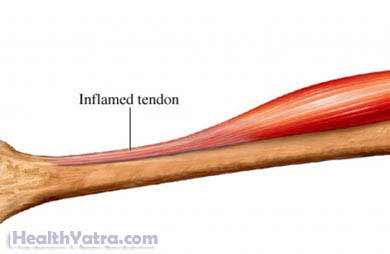Definition
Tendons connect muscle to bone and help move joints. Tendinopathy is an injury to the tendon. These injuries tend to occur in tendons near joints such as knee, shoulder, and ankle. The injuries can include:
- Tendinitis—an inflammation of the tendon. Although this term is used often, most cases of tendinopathy are not associated with significant inflammation.
- Tendinosis—microtears (tiny breaks) in the tendon tissue with no significant inflammation.
The following tendons are often involved:
- Achilles —back of heel
- Rotator cuff in the shoulder
- Biceps in the shoulder
- Wrist extensors near the elbow, on the outside
- Wrist flexors near the elbow, on the inside
- Patellar tendon, which is attached to the kneecap
Tendinopathy and the associated pain may take months to resolve. You may need medication for pain relief.

Causes
Tendinopathy is caused by overuse of a muscle-tendon unit. The strain on the tendon causes very tiny tears that accumulate over time. These tears cause pain and can eventually change the structure of the tendon.
Overuse can be the result of doing any activity too much, such as:
- Sport activities
- Physical labor, especially those with repetitive motions
- Housework
Risk Factors
Tendinopathy is more common in women than in men. Factors that may increase your chance of getting tendinopathy include:
- Muscle imbalance
- Decreased flexibility
- Overweight
- Advancing age
- Alignment abnormalities of the leg
Symptoms
Symptoms may include:
- Pain, particularly with activity
- Decreased motion of related joints
- Local swelling
Diagnosis
The doctor will ask about your symptoms and medical history. A physical exam will be done.
If your symptoms are severe your doctor may need some images of the tendon and bone. Imaging tests may include:
- X-ray
- MRI scan
Treatment
Treatment depends on:
- Severity of symptoms
- The tendon involved
- Length of time symptoms have lasted
Talk with your doctor about the best treatment plan for you. Options may include:
- Avoiding the activity that is responsible
- Reduce shock vibration on the joint
- Rest for the affected tendon
- Ice after activity
- Cast or splint for immobilization of the affected area
- Counterforce brace over the painful tendon
- Shoe orthotics for foot alignment problems
Your doctor or physical therapist may recommend exercises or a rehabilitation program.
Medication
To manage pain or swelling, your doctor may recommend:
- Over-the-counter pain relievers, such as acetaminophen or non-steroidal anti-inflammatory medication (NSAIDs)
- Prescription pain relievers
- Topical pain relievers, such as creams or patches that are applied directly to the skin
A medication call cortisone may be used. It can be injected into the sheath around the tendon.
Prevention
To prevent tendinopathy:
- Gradually work yourself into shape for a new activity.
- Gradually increase the length of time and intensity of activities.
- If you have a tendon that has been a problem, gradually stretch out that muscle/tendon unit.
- Strengthen the muscle to which the tendon is attached.
- If you have pain, do not ignore it. Early treatment can prevent the problem from becoming serious.
- Learn to back off from activities if you are tired or not used to the activity.
- Warm-up the affected area before activity.
